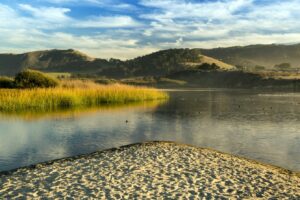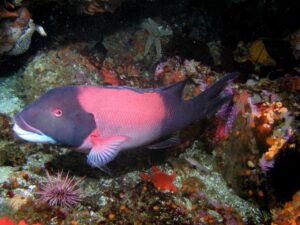MPA Monitoring Series: Ask the Researcher, Part 4: Estuaries and Mid-Depth Rocky Habitat
In the final “Ask the Researcher” webinars held in August, participants discussed important MPA monitoring projects in estuarine habitats and mid-depth rocky habitats. To learn more about this exciting summer series and the previous webinars, check out: Ask the Researcher, Part 1: Kelp and Rocky Intertidal Ecosystems, Part 2: Ocean Observing Systems and Sandy Beach Ecosystems, and Part 3: CCFRP and Commercial & CPFV Fisheries.
Condition Assessment & Monitoring of Estuaries

An estuary is an area where freshwater mixes with saltwater. Photo: Doug Steakley
Dr. Kevin O’Connor and Dr. Ross Clark with the Central Coast Wetlands Group at the Moss Landing Marine Laboratories co-led the first of the final two webinars: Condition Assessment & Monitoring of Estuaries (PDF). Estuaries are important habitats, feeding grounds, and nurseries for offshore species. Dr. O’Connor introduced the status of estuary marine protected area (EMPA) monitoring in California, which lacked a standard systematic program to track the health of these vital ecosystems. A project team led by Dr. Ross and Dr. Clark developed the first monitoring framework for EMPAs used to collect the baseline data needed to answer overall MPA management questions. By gathering baseline data in 23 EMPAs, scientists can better understand the ecological connections between coastal and offshore protected areas.
Under the guidance of a Management Advisory Committee, the project team developed 14 standard operating protocols (SOPs) for long-term estuary monitoring, viewable in an EMPA data repository. The team also utilized the California Rapid Assessment Method (CRAM) to develop wetland index scores for 15 sites across the California coast to establish the first inventory-scale data collection in estuaries. Furthermore, a function-based assessment evaluated the condition of EMPAs and reference sites in 2021, forming the first statewide estuarine data collection in the MPA Network. The data is currently undergoing analysis and will be released in a final technical report in early 2023.
Dr. Clark presented four preliminary findings of the assessment:
- Overall condition of habitats appeared to have little difference both within and outside MPA designation.
- Physical metrics such as dissolved oxygen and water chemistry, which are critical to fish and invertebrate communities, appeared highly variable across all sites, all locations within the sites, and all estuary types.
- The condition of the river mouth, whether it is open or closed, has a strong influence on physical metrics like dissolved oxygen.
- Differences in fish abundance between MPAs and reference sites were difficult to see due to seasonal variability, estuary type, and lack of long-term data.
Watch the Condition Assessment & Monitoring of Estuaries webinar recording for more detailed observations and background on the assessment development.
Mid-Depth Rocky Habitats
Dr. Rick Starr from Moss Landing Marine Laboratories led the Mid-Depth Rocky Habitat (PDF) monitoring project webinar. The project used advanced video systems to assess fish and invertebrate responses in MPAs, particularly in the mid-depth rocky habitats. Most of California’s coastal waters are comprised of this habitat, which lies 30 to 100 meters below the sea surface and contains around 200 different fish species. Many of these species are ecologically and economically important.
The Mid-Depth Rocky Habitats monitoring project used a variety of new and established video technology methods to effectively capture data in deeper waters across its 30 years of data collection. These tools included the Delta sub, Beagle ROV (remotely operated vehicle), video lander, and BRUV (baited remote underwater video). Paired MPAs and reference sites were chosen and mapped based on similarities in bathymetry (water depth), substrate type, substrate slope, and substrate complexity. With these tools, existing literature on the habitat, and extensive California seafloor maps, the project team created a detailed habitat assessment to determine MPA responses.

The California Sheephead is found in mid-depth rocky habitats. Photo: CDFW / Matt Elyash
Dr. Starr shared a few key findings of this study:
- Rocky reef and “high quality” habitat are not uniformly distributed along the coast, with more high-quality habitat found in northern and central California. However, MPA and reference sites were found to have similar amounts of “high quality” habitat.
- MPA effects varied across fish species, habitats, and years. Some species of harvested fish and invertebrates saw strong MPA effects, such as increased density of California sheephead and sea cucumbers in the south coast.
- No clear trends in fish densities due to MPA were seen; the response of 43 fish species was variable across MPAs and reference sites. Most focal fish and invertebrate species did not have significantly different density slopes over time.
- A species of concern, the sunflower star, was monitored and saw densities drop to almost zero in recent years due to sea star wasting disease.
- There was an overall increase in fish biomass, species diversity, and reproductive output since 2010 in both MPAs and reference sites. BRUVs showed significant differences between biomass of fished vs. unfished species.
For more detailed information, watch the Mid-Depth Rocky Habitats webinar recording.
Further Exploration
These two webinars conclude the “Ask the Researcher” MPA Monitoring webinar series. We would like to thank all the speakers and their teams, and all the webinar attendees. Additional thanks to the staff at OPC, Strategic Earth, and CDFW who facilitated these webinars.
You can read the full MPA monitoring reports for all the MPA research projects on California Sea Grant’s website. Short on time? Check out the two-page snapshot summary reports available in both English and Spanish. All the baseline and long-term monitoring data are available on the new California MPA data portal.
You can now view all eight of the post-webinar summaries on our blog and watch the webinar recordings on our YouTube channel.

